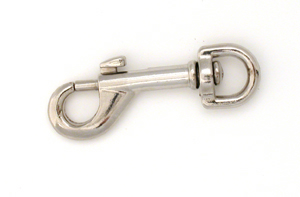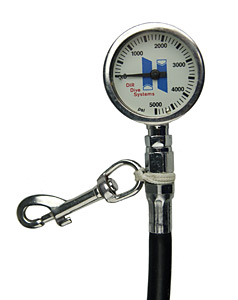Part of the reason I am posting is to find out if all this is needed. I also only have what was required by my LDS for the training I am doing.
It may be required for the individual dives, but not every dive. For recreational diving, I consider the following to be 'standard':
1x Deployable Surface Marker Buoy (DSMB)
i.e. A safety sausage that should be able to retain the air you put into it on ascent and at the surface. Ideally, they should be closed or semi-closed.
1x Finger Reel of 30-25m lengths, with Stainless Steel Double Ended Bolt-Snap.
1x Small Dive Knife.
Make sure it is sharp and capable of cutting monofilament line.
1x Whistle.
For signalling at the surface.
1x Small Torch.
LED bulbs and AA battery powered.
Other stuff is dive specific according to the plan. Bigger torches, slates (instructional, maps, deco info, fish ID), tools (wreck dives),lift bags, redundant depth/timers, emergency signalling DSMBs.... etc etc etc
Not sure if I have a DSMB. I have a 6' safety sausage but from the decription of DSMB I do not think they are the same. I bought a small (3-4") Deepsee knife which attaches to my BC via gromets.
Some divers refer to a DSMB as a safety sausage - but normally a 'sausage' is nothing more than a glorified plastic bag, incapable of holding air at the surface and liable to leak at any time. Given that this is an emergency device (signalling, ascents in shipping areas, ascents in currents/drifts), then I wouldn't skimp on this equipment. I find the smaller sized (3ft) 'closed' DSMBs, that use oral inflation, to be ideal for me diving in the tropics. In rougher waters (back in the UK), I would use a larger DSMB...normally the semi-closed ones that you fill by exhaled air from the reg.
Any brand of knife is sufficient, although I prefer titanium ones as they hold their edge. Get some monofilament (fishing) line and make sure you can cut through it underwater...this is a good test of a blade.
Hmm, my clips for my octopus and console and plastic clips. Although I am considering removing the octopus one and going to the bungee method mentioned above. I will look into making a console attachment using what you said though.
I use these clips for everything. Once you've mastered the knot required they take 5 mins to attach to your kit and are permanent (unless you want to cut them free). They cost no more (often less) than the silly, fancy ones that you can buy in dive shops.
I like this idea since I hated the thought of everything dangling off of me.
That's a good principle to stick with...be ruthless with your kit.

I have a dive computer but was carrying a depth gauge and SPG in the case the computer fails. I would have to ascend but I could keep diving using those, a timer, and my tables. Although maybe I should go to a SPG only and keep the dual console in a save a dive kit or something.
If you are only doing recreational diving, then you are unlikely ever to need redundant depth, time or air gauges. If anything malfunctions, then you will immediately call the dive, ascend and do a safety stop. As you'll never be over a no-deco limit...you can always count on that direct ascent to the surface.
If you want to dive again...then 'technically' you'd be breaking the rules if you ignored your dive computer manufacturers recommendations (
normally, they say sit out of diving for 24 hours). However, you'll always have your buddy to provide max depth for the dive - plus you should be aware of your own max depth for the dive and (
after failure) you won't be going any deeper will you? And you should always know your descent time (
I hope)...so you can still try your luck at planning subsequent dives on tables.....but chances are that if you are repetitive deepish (
18-30m) diving on a computer, you may be well over table limits anyway.
Well, having read the standards, it would be allowed (as would primary donation techniques)...but the difficulty arises from not being configured in the same way as my students - no chance of convincing my dive resort to buy long hoses for all the students...







